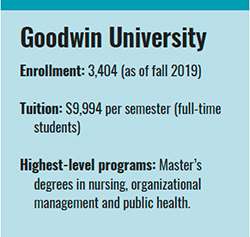
Processing Your Payment
Please do not leave this page until complete. This can take a few moments.
-
News
-
Editions
-
- Lists
-
Viewpoints
-
HBJ Events
-
Event Info
- 2024 Economic Outlook Webinar Presented by: NBT Bank
- Best Places to Work in Connecticut 2024
- Top 25 Women In Business Awards 2024
- Connecticut's Family Business Awards 2024
- What's Your Story? A Small Business Giveaway 2024 Presented By: Torrington Savings Bank
- 40 Under Forty Awards 2024
- C-Suite and Lifetime Achievement Awards 2024
- Connecticut's Health Care Heroes Awards 2024
-
-
Business Calendar
-
Custom Content
- News
-
Editions
View Digital Editions
Biweekly Issues
- April 29, 2024
- April 15, 2024
- April 1, 2024
- March 18, 2024
- March 4, 2024
- February 19, 2024
- February 5, 2024
- January 22, 2024
- January 8, 2024
- + More
Special Editions
- Lists
- Viewpoints
-
HBJ Events
Event Info
- View all Events
- 2024 Economic Outlook Webinar Presented by: NBT Bank
- Best Places to Work in Connecticut 2024
- Top 25 Women In Business Awards 2024
- Connecticut's Family Business Awards 2024
- What's Your Story? A Small Business Giveaway 2024 Presented By: Torrington Savings Bank
- 40 Under Forty Awards 2024
- C-Suite and Lifetime Achievement Awards 2024
- Connecticut's Health Care Heroes Awards 2024
Award Honorees
- Business Calendar
- Custom Content
More U.S. colleges are converting to a university. Here’s why.
 Photo | Contributed
Faculty at Goodwin University, including President Mark Scheinberg (center), celebrate the school’s new “University” designation.
Photo | Contributed
Faculty at Goodwin University, including President Mark Scheinberg (center), celebrate the school’s new “University” designation.
When Mark Scheinberg stepped on stage earlier this month in the main auditorium of his East Hartford school, the words projected on the screen behind him were also emblazoned on excited-looking faculty members’ sweatshirts.
Goodwin University.
Until that January morning, the school he founded in 1999 was called Goodwin College. But with the addition of master’s degree programs in nursing, public health and organizational leadership, it was time for Goodwin’s name to reflect a higher stature, Scheinberg said.
“In our case, there was no one out there doing those sorts of master’s degrees that weren’t calling themselves a university,” Scheinberg said in an interview. “This could be a real game-changer.”

Goodwin’s shift from a college to a university isn’t wholly unique, especially among smaller schools looking to gain greater notoriety as the higher-education industry faces significant headwinds, including a declining customer base and exceedingly high costs.
The University of St. Joseph in West Hartford shed its college tag in 2012, and a spate of small colleges in Massachusetts, including Westfield State University and Lasell University, have done the same in recent years.
Adopting the more prestigious-sounding “university” tag has multiple benefits, school officials and industry experts say. Universities can use the rebranding to re-introduce their institution to prospective students, and it can be particularly impactful with international recruitment. Many non-U.S. students hail from countries where “college” refers to what the U.S. calls “high school.”
But even though universities are generally thought of as offering more programs than colleges, the definition of what a university actually is varies from state to state. In Massachusetts, for example, a university must have at least two unrelated doctoral programs, while Connecticut’s Department of Higher Education (DHE) doesn’t actually distinguish between the two.
So, if Goodwin was located 27 miles north across the Massachusetts border, it could not call itself a university. (Scheinberg said Goodwin is considering adding doctoral programs in the future.)
“In terms of the regulations and statutes that exist, these higher-education institutions are just called ‘higher-education institutions,’ ” said Sean Seepersad, director of the DHE’s academic-affairs division.
The only thing that could bar a Connecticut school from calling itself a university would be if it’s small enough to irk the regional accreditor — the New England Commission of Higher Education (NECHE).
NECHE President Barbara Brittingham said her organization doesn’t specifically define what a university is either, and handles college-to-university conversions on a case-by-case basis.
NECHE has never told a school under its purview it can’t call itself a university, she added.
“The Commission [oversees] a small number of places that are very small,” said Brittingham, adding that schools with fewer 200 students fit this category. “I think if one of those wanted to change to a university the Commission might want to have a conversation.”
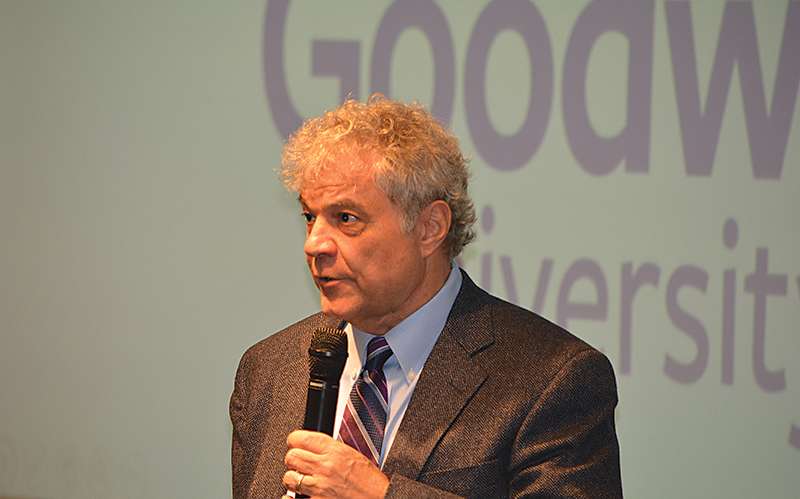
Goodwin’s evolution
Scheinberg bought Goodwin in 1981. Back then it was known as the Data Institute Business School, a tiny for-profit institution. He rebranded it as Goodwin College in 1999, and in 2004 it received NECHE accreditation. Now it’s a private, nonprofit, career-focused institution that offers certificate programs in addition to associate, bachelor’s and master’s degrees.
Goodwin’s current enrollment is about 3,400 students, the school said. Scheinberg and other administrators say that size plus the number of four-year and master’s degree programs it offers means “university” more accurately describes the school than “college,” especially in Connecticut.
As part of the new university designation, Goodwin will break up its five academic departments into three schools: the School of Nursing and Health Professions; the School of Business Technology and Advanced Manufacturing; and the School of Applied Liberal Arts and Social Sciences.
Additionally, becoming a university could encourage more corporations to enlist Goodwin for employee training and degree programs, Scheinberg said.
Four higher-ed institutions that offer master’s degree programs currently operate in Connecticut as colleges: Albertus Magnus College, Charter Oak State College, Connecticut College and Trinity College.
Why change?
Colleges often rebrand as universities to showcase expanded programming, new facilities or sometimes just to get their names out there, said Anne Callahan, principal and co-founder of Boston marketing firm Kor Group Ltd., which serves higher-education clients including College of the Holy Cross and New England Law.
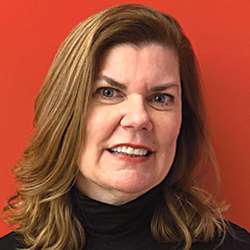
Even though institutions making the change essentially just swap “college” for “university,” changing signage, letterheads and anything else that refers to the school by name can be an expensive process, Callahan said.
Goodwin said its rebranding process could cost up to $1 million, but there are no plans to raise tuition to coincide with the name change.
“It’s almost like a global rebrand, everything has to be changed to reflect the university’s name,” Callahan said.
Colleges looking to become universities should show some kind of change in the institution (i.e. growth, as in Goodwin’s case) that ties into the name change.
In addition to new programs, Goodwin’s campus along the Connecticut River in East Hartford has undergone major transformation over the years. Most recently, the school in October broke ground on a 25,000-square-foot, $8-million commercial building that aims to help revitalize the school’s South Main Street section.
It will also soon debut a manufacturing-education annex.
A recent conversion
When St. Joseph College became the University of St. Joseph in 2012, the school had added its first doctoral program (in pharmacy), and was developing another in nursing, said USJ Provost Michelle Kalis.
“We were a complex institution, and felt at that time that university better reflected what we had become,” Kalis said. “More specifically, it was to reflect the nature of the institution having degrees at all of these levels: bachelor’s, master’s and doctoral.”
USJ also thought the university title could make it more appealing to international students, Kalis said.
For Goodwin, the change is garnering early excitement.
“In terms of our alumni, we’ve had over 50 requests so far from people asking to have their diplomas re-issued under the university name,” Scheinberg said. “We’ve also got some just really nice responses from other colleges in the area that wondered what took us so long.”
Related Content

2022 Giving Guide
This special edition informs and connects businesses with nonprofit organizations that are aligned with what they care about. Each nonprofit profile provides a crisp snapshot of the organization’s mission, goals, area of service, giving and volunteer opportunities and board leadership.
Learn more
Subscribe
Hartford Business Journal provides the top coverage of news, trends, data, politics and personalities of the area’s business community. Get the news and information you need from the award-winning writers at HBJ. Don’t miss out - subscribe today.
Subscribe
2024 Book of Lists
Delivering Vital Marketplace Content and Context to Senior Decision Makers Throughout Greater Hartford and the State ... All Year Long!
Read Here-
2022 Giving Guide
This special edition informs and connects businesses with nonprofit organizations that are aligned with what they care about. Each nonprofit profile provides a crisp snapshot of the organization’s mission, goals, area of service, giving and volunteer opportunities and board leadership.
-
Subscribe
Hartford Business Journal provides the top coverage of news, trends, data, politics and personalities of the area’s business community. Get the news and information you need from the award-winning writers at HBJ. Don’t miss out - subscribe today.
-
2024 Book of Lists
Delivering Vital Marketplace Content and Context to Senior Decision Makers Throughout Greater Hartford and the State ... All Year Long!
ABOUT
ADVERTISE
NEW ENGLAND BUSINESS MEDIA SITES
No articles left
Get access now
In order to use this feature, we need some information from you. You can also login or register for a free account.
By clicking submit you are agreeing to our cookie usage and Privacy Policy
Already have an account? Login
Already have an account? Login
Want to create an account? Register
Get access now
In order to use this feature, we need some information from you. You can also login or register for a free account.
By clicking submit you are agreeing to our cookie usage and Privacy Policy
Already have an account? Login
Already have an account? Login
Want to create an account? Register
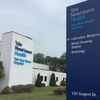





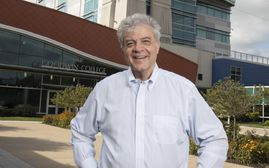

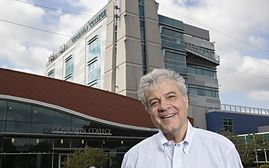
0 Comments